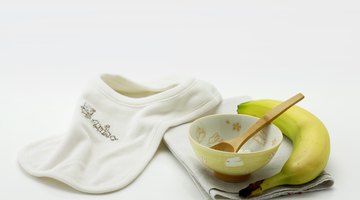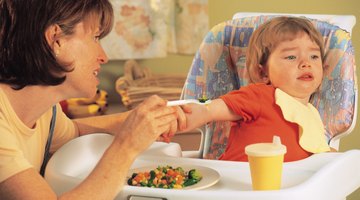How Much Solids for a 7-Month-Old?
Quitting the Liquid Lunch: Transitioning Babies From Milk or Formula to Solids
Babies can handle up to 8 to 12 tablespoons of solid food (around 8 to 12 ounces) a day by 7 months old. And while you've probably already started incorporating little nibbles like cereals, veggies and fruit by 7 months, following a plan that slowly phases out breast milk or formula incrementally helps smooth the transition.
Timing the Transition

What Foods Can a 7-Month-Old Baby Eat and How Much?
Learn More
If you breastfeed, don't feel you have to push a solid-heavy diet on your little one. According to the American Academy of Pediatrics, babies breastfed to at least 6 months old have less chance of growing overweight, a reduced risk of diabetes and better weight control later in life.
The AAP recommends that liquids compose a portion of a baby's diet until 12 months, so at 7 months you have some time to make the move to solids. When the time comes to start the liquids-to-solids transition, you'll see an emergence of fine and gross motor skills and weight gain. Look for these traits:
- Holding his head upright
- Closing his mouth around a spoon
- Losing the extrusion reflex, which causes him to spit food out using his tongue
- Weighing double his birth weight (at least 13 pounds)
- Sitting upright in a feeding chair
If you haven't started your baby on solids yet, offer a test tablespoon or two of vegetable or fruit puree when you see he can handle it. If he handles those little tastes with ease, feel free to go wheels up on a liquids-to-solids transition.
Making the Move
Initiate the transition in meal-by-meal increments. For example, start a meal with a little breast milk or formula, change over to a few small spoonfuls of solid food and finish with a little breast milk or formula.
By 7 months old, your baby can eat 8 to 12 tablespoons (about 1/2 to 1 cup) of solid food as "snacks" in between three to five feedings of 6 to 8 ounces of breast milk or formula each (24 to 32 ounces total daily).
Planning a Menu

List of Table Foods My 1 Year Old Can Eat
Learn More
Babies have sensitive, undeveloped palates, so simple works best. Whole, unprocessed foods and grains offer the most nutrition when consumed along with breast milk or formula. Grains and iron-fortified cereals such as brown rice, oats and barley; proteins like pureed tofu, chicken, beef and pork; and fruit and veggie purees including bananas, apples, sweet potatoes and squash make for a varied selection of starter solids to build a "menu" around.
As your baby grows from 7 to 9 months of age, you can increase her intake of solids in these ranges:
- 1 teaspoon of fruit a day to 3 or 4 tablespoons over four feedings
- 3 tablespoons of cereal grains a day to 9 tablespoons over two to three feedings
- 1 teaspoon of vegetables a day to 2 or 3 tablespoons over four feedings
Tips
- You can introduce new foods in any order, but do so one at a time.
- If your baby has a history of allergies, keep a food log in the event she suffers an adverse reaction to a new food.
- Encourage diverse eating. Covering an array of foods types will engage your little one's developing palate and make her more receptive to new foods.











